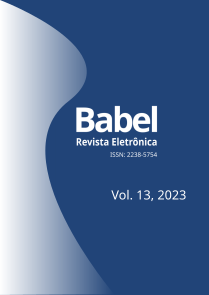Memes: from the senses to multimodalities in digital social networks
DOI:
https://doi.org/10.69969/revistababel.v13i.19127Keywords:
Memes; Language teaching; Multimodality; Social media.Abstract
ABSTRACT: This text aims, through review and dialogue with the literature in the area, to show that memes, a hybrid discursive genre native to the digital environment, are a powerful object for teaching multimodality and construction of meaning. In memes, there is a visual design that aggregates multiple languages and expands the construction of meanings. In this way, it reflects on linguistic and digital education through visual design and the distribution of meanings socially recognized in the meme-text. Furthermore, promotes multiliteracies in the classroom from basic education to higher education, applying multimodality, which is a hallmark of online communication and interaction. It is concluded that the pedagogical way of the school tradition of teaching reading, seeking meanings from texts recognized in the culture of printed literacy, where the verbal was privileged for decades to the detriment of the visual, must open its borders and expand them to the point that the multiple matrices of languages current on digital communication and social network platforms are incorporated into these repertoires, where the multimodality associated with visual design guarantees the resignification of meanings and ideologies contained in memes.
KEYWORDS: Memes; Language teaching; Multimodality; Social media.
Downloads
References
BACCEGA, M. A. Palavra e discurso: história e literatura. São Paulo: Ática, 2000.
BARRETO, R. P. De fora para dentro: Memes e as práticas multimodalidades na sala de aula Língua Portuguesa. Curitiba: Atena Editora, 2022.
BARRETO, R. P., & SANTOS, C. P. A travessia do leitor: do livro impresso à tela. Em D. J. CÉSAR, & D. M. CARVALHO, Pesquisas no ensino básico, técnico e tecnológico: indisciplinaridades 2 (pp. 126-135). Rio Branco: Stricto Sensu, 2021
BARTON, D., & LEE, C. Linguagem online: textos e práticas digitais. São Paulo: Parábola Editorial, 2015
BLACKMORE, S. La Máquina de los memes. Barcelona: Ediciones Paidós Ibérica, 2000.
CANCLINI, N. Leitores, espectadores e internautas. São Paulo: Iluminuras, 2008.
CHARTIER, R.. A aventura do livro: leitor ao navegaror. São Paulo: UNESP, 1998.
DAWKINS, R. O gene egoísta. São Paulo: Companhia das Letras, 2007.
DIAS, C.. Análise do discurso digital: sujeito, espaço memória e arquivo. Campinas: Pontes Editores, 2018.
HURTADO, G. Sujeto, persona y sentido. Em U. PINHEIRO, M. RUFFINO, & P. J. SMITH, Ontologia, Conhecimento e linguagem (p. 328). Rio de Janeiro: MAUAD, 2001.
JENKINS, H. Invasores de textos: fãs e cultura participativa. Nova Iguaçu, RJ: Masrsupial Editora, 2015.
MILLER, C. Genre as social action. Quarterly journal of Speech, 151-167, 1984.
MILLER, C., & SHEPHERD, D. (27 de julho de 2004). https://conservancy.umn.edu/handle/11299/172818. Acesso em 13/12/2022 de 2022 de 2022, disponível em https://conservancy.umn.edu.
PAVEAU, M.-A. Análise do discurso digital: dicionário das formas e das práticas. Campinas: Pontes Editores, 2012
SALOMON, G. Editor's Introduction. In: distributed Cognitions Psycological and Educational considerations. Cambridge: Cambridge University Press, 1993
SHIFMAN, L. Memes in digital culture. Massachusetts: MIT press essential knowledge, 2014
Published
How to Cite
Issue
Section
License
Copyright (c) 2023 Babel: Revista Eletrônica de Línguas e Literaturas Estrangeiras

This work is licensed under a Creative Commons Attribution-ShareAlike 4.0 International License.
Os autores detém os direitos autorais sem restrições, porém ao submeter os originais, concordam em transferir a este periódico os direitos da primeira publicação. Isto deve ser informado em caso de nova edição do texto. As produções que derivarem deste material, devem obrigatoriamente citar a fonte. Os textos publicados nesta revista, salvo indicações contrárias, encontram-se sob uma licença Creative Commons Atribuição 4.0 Internacional.

